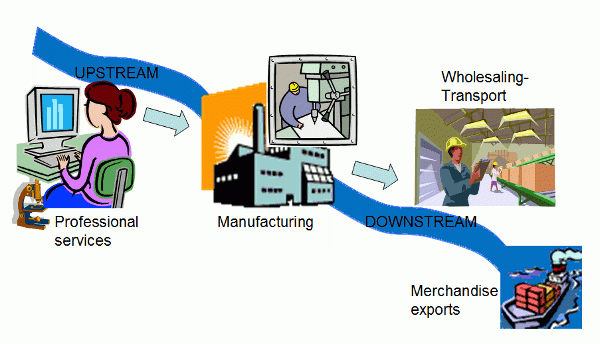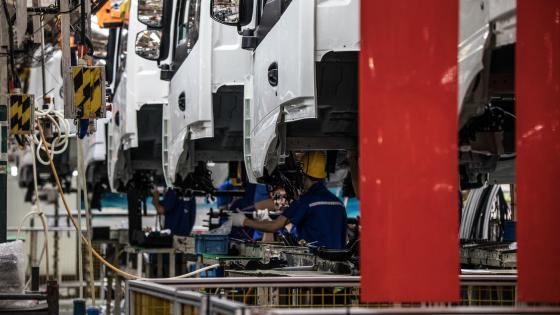The US economy has shifted from production to services. The Dow Jones index, which was formerly populated by companies like US Steel and Amalgamated Copper, is now composed of companies like Citigroup, Microsoft, and Wal-Mart. Last year the manufacturing sector accounted for 11% of US GDP, whereas finance, insurance, and real estate alone accounted for roughly 20% (BEA 2009a).
Exports are one place where this structural change is less evident. Manufactured goods make up more than half the value of all US exports, and over 80% of goods exports are manufacturing exports.
While export promotion is often seen as a strategy of increasing manufacturing employment, in the past decade US employment growth has all been in the services sectors. Even though manufacturing is important in itself, the promotion of US exports is likely to generate more indirect jobs in wholesaling, transport, and professional services than direct jobs in manufacturing.
Employment trends support growth in services over manufacturing
In recent years there has been a downward trend in US manufacturing employment.
- Productivity in the manufacturing sector has been on the rise, reducing the demand for workers in manufacturing.
- Manufacturing employment decreased by an average of 2.6% per year in the period from 1998 to 2006 with a total decrease of 19.6% over the period, as can be seen in Figure 1.
- At the same time, the manufacturing sector experienced a 15.6% increase in multifactor productivity (authors’ calculations based on SBA 2009 and BLS 2009).
As new technologies in manufacturing are often embodied in capital equipment, advances in productivity in the manufacturing sector commonly translate into a greater substitution of capital for labour, causing downward pressure on manufacturing employment. The substantial decline in manufacturing employment during the recession of 2001 and the lack of recovery in the period after the recession is not surprising given the observed increases in manufacturing productivity and the noted link between increasing productivity and periods of recession (Caballero and Hammour 1994). It seems unlikely, then, that manufacturing employment will be the source of drastic job growth in coming years.
While manufacturing employment is declining, it is also clear from Figure 1 that employment has been increasing in services that are upstream and downstream from manufacturing.
- Services that are upstream from manufacturing, such as financial services, real estate and professional and technical services, occur before production and represent inputs to production.
- Services that are downstream, such as wholesaling, transportation and storage occur after production.
Upstream and downstream services experienced increases in employment of 24.1% and 10.7%, respectively, from 1998 to 2006, while manufacturing employment declined. These trends appear to be driven by enduring changes in the way production is organised and are unlikely to reverse themselves in the near to intermediate future.
Figure 1. Employment in upstream and downstream services and manufacturing, 1998-2006
Source: Authors’ calculations, based on data from the US Small Business Administration (2009).
Services are a sizeable input to manufactured goods and merchandise exports
Both upstream and downstream services are embodied in the value of final manufactured goods, as depicted in Figure 2. In 2007, services amounted to 23% of the costs for each dollar of US manufacturing output. For computers and electronics, one of the more significant export categories, more than 32% of costs consisted of services inputs (BEA 2009b). It is also worth noting that previous research has found that the share of services as an input to a country’s manufacturing exports is significantly correlated with the country’s per capita income (Francois and Woerz 2008).
Figure 2. Upstream and downstream services
In the US, downstream services play a particularly important role in the sale and export of manufactured goods. In our data on US exports in 2005, wholesaling and non-manufacturing companies are the exporters of record for roughly 33% of US goods exports (authors’ calculations based on OECD 2010).
According to Tschetter (2010), the direct and indirect services employment embodied in US goods exports make up nearly 39% of the total employment supported by goods exports. Exports of goods supported 7.5 million jobs in 2008. Of these, at least 1.4 million were in upstream services such as finance, information, and professional services and another 1.5 million were in wholesale trade, transport, and warehousing.
When exports of both goods and services are considered, manufacturing is still the sector with the single largest share of export-supported jobs, although upstream and downstream services together account for a larger share than manufacturing. Moreover, Tshetter finds that the share of export-supported jobs in professional and business services has steadily increased since 1993, while the share in manufacturing has declined.
Promoting goods exports should increase employment in services
These stylised facts suggest that services employment will increase if goods exports grow at a significant rate. For every good that is exported there are typically R&D efforts to design the product, financing and technological services to keep the factory running, wholesalers to sell the good, and transport services to ship it. Increasing merchandise exports would certainly generate employment in downstream services (e.g. transportation) and would likely generate additional employment in upstream services used as inputs to manufacturing. The service sectors also have lower output per worker than manufacturing (USITC 2009), which is another way of saying they are more labour-intensive. Any additional demand for services is therefore even more supportive for job creation in the US economy.
There are other reasons to believe that export promotion may promote services employment.
- First, services themselves are exported directly as well as indirectly. Services exporters typically face unique barriers, for example, requirements about local presence and nationality, limited recognition of foreign qualifications, and restrictions on direct investment. (USITC, 2009). If some of these barriers are mitigated, the value of US direct services exports, and thus services employment, could increase disproportionately.
- Second, recent US policies emphasise exports by small and medium-sized enterprises (SMEs). Since SMEs are less vertically integrated than large companies, they may be more likely to contract for specialty services, especially upstream ones like accounting, IT, and website design. An increase in the share of US exports accounted for by SMEs may thus increase the share of upstream services and employment as an input to manufacturing production.
- Finally, US SME exporters are more likely to be wholesalers than manufacturers (USITC 2010), which suggests that efforts to expand SME exports could usefully take account of the role of SME intermediaries.
Some observers have expressed scepticism about the idea that rapid growth in exports is a viable strategy for increasing US employment. Among the points raised are the tendency for rational, cost-saving firms to relocate manufacturing jobs overseas (Weitzman 2010). Job creation in the services sectors has fewer obstacles to overcome than in the manufacturing sector given the existing upward trend in services employment. A greater appreciation of the forward and backward linkages associated with exports, particularly the linkages associating services with goods exports, would likely enhance the employment-generating potential of policies designed to promote exports.
This column reflects solely the views of the authors and does not reflect the views of the US International Trade Commission or any of its Commissioners.
References
BEA (2009a), “Value Added as a Percentage of Gross Domestic Product”. Annual Industry Accounts.
BEA (2009b), Measuring the Nation’s Economy: An Industry Perspective.
BLS (2009), Major Sector Multifactor Productivity.
Caballero, Ricardo J and Mohamad L Hammour (1994), “The Cleansing Effect of Recessions,” American Economic Review, 84(5):1350-1368.
Francois, Joseph and Julia Woerz (2008), “Producer Services, Manufacturing Linkages, and Trade”. Journal of Industry, Competition and Trade, 8(3):199–229.
OECD (2010), “Trade by Enterprise Characteristics Database”, pre-release for US International Trade Commission.
Tschetter, John (2010), “Exports Support American Jobs”, US Department of Commerce International Trade Research Report 1.
US International Trade Commission (2010), “Small and Medium-Sized Enterprises: U.S. and EU Export Activities, and Barriers and Opportunities Experienced by U.S. Firms”, Investigation 332-509, USITC Publication 4169.
USITC (2009), “Recent Trends in U.S. Services Trade”, Investigation No. 332-345, USITC Publication 4084.
US Small Business Administration, Office of Advocacy (2009), “Statistics of U.S. Businesses” (based on data from the U.S. Department of Commerce Bureau of the Census).
Weitzman, Hal (2010), “Obama’s Export Drive is ‘Misdirected”, Financial Times, 28 June.






